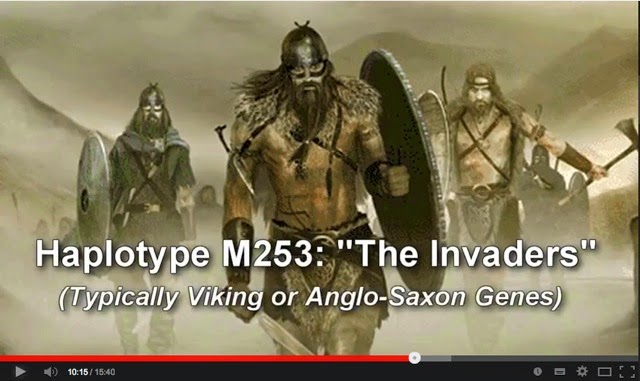Following on from the previous post, as the layers and centuries of history are peeled back, they often reveal the story of the Normans - in Great Britain, in Ireland and in Ulster. Many of the families celebrated as Ulster-Scots in fact have French origins - the De Montgomeries and the De Hambledens (Hamiltons) were both from Normandy. The Montgomery Manuscripts refer to customs of Lowland Scottish gentry being 'in imitation of ye French ... there is plenty of French names and French words alsoe'. The De Brus family, of whom descended King Robert the Bruce, is another example of 'Scoto-Norman'. The same applies to many Irish families.
The Normans were of Viking descent thanks to their leader, Rollo, being given Normandy by the King of France in a famous treaty in AD911 - he had grown tired of defending against relentless Viking attacks. 150 years later, in AD1066, the Normans had grown powerful enough to invade and take control of England. The Bayeux Tapestry is the 230 foot long HD widescreen Blu-Ray account of the Battle of Hastings which was the clincher - the Bannockburn of its day which installed a new King and changed a nation.The first step was England, then north into Scotland and then west into Ireland and northwards into Ulster.
This Viking Ulster-Scots connection might explain my white eyebrows, a physical quirk which has got me occasional bouts of stick and banter over the years! The very kind Mary Becker from California who administers the Ards Peninsula Families Project on FamilyTreeDNA.com got me involved in this a few years ago and my result was Haplogroup I-M253. This is described as 'lineage which likely has its roots in northern France. Today it is found most frequently within Viking / Scandinavian populations in northwest Europe'. Here is a map from Wikipedia:

The Anglo-Norman and Scoto-Norman story is not well known - despite the survival of an array of very impressive castles, abbeys and priories which they established and can still be visited and wondered at today. The VisitStrangfordLough.com website has some of them, but they are scattered in among a selection of other historic buildings and houses (see here). The Co Down Anglo-Norman castles are nowhere nearly as well marketed as, for example, the Fermanagh Plantation castles of the early 1600s.
One of the ways of dissolving our 'two tribes' stereotype is simply to tell the full historical story, not a selective one which equips and fuels the present-day political disputes.
Who were these Anglo-Normans? What were their names? How did they live? How many of them were there? What region did they 'occupy', and whose territory was it before they arrived? What type of religion did they practice, and did they impose their own religion on the locals? And who gave them permission to come to Ireland in the first place - was it Pope Adrian IV who gave approval to King Henry II of England in his Laudabiliter of 1155 (a document which itself has been reappraised)? And was it an 'invasion' or were there prior alliances, such as the King of Leinster (Dairmiud MacMorrough) who enlisted Richard de Clare ('Strongbow') from Wales in his fight against his 'fellow Irishmen' the High King of Ireland and the King of Briefne. What mottes survive, what townland names survive? And were they of one mind or did they have their own internal rivalries and feuds? What are all the things we can see and touch and photograph today which these Normans built? Can we hold medieval events in them? Can we re-enact battles and invasions as major spectacles, like at Bannockburn last weekend?
Renowned historian Simon Schama has written about the Anglo-Normans in Ireland. The National Archives website also has some interesting content.
But, thus far, the Anglo-Norman story has not been 'packaged' for tourism and the many interesting castles and abbeys do not have this story as a connecting narrative. These places could become a string of pearls, with the added benefit of helping people understand how multicultural the history of Ulster, Ireland, Scotland and the British Isles as a whole really is.
More on the Anglo-Normans of Strangford Lough to follow.
........
This YouTube video about Haplogroup I-M253 includes the image below. People with white eyebrows can be seen at 9min 05seconds!




0 comments:
Post a Comment